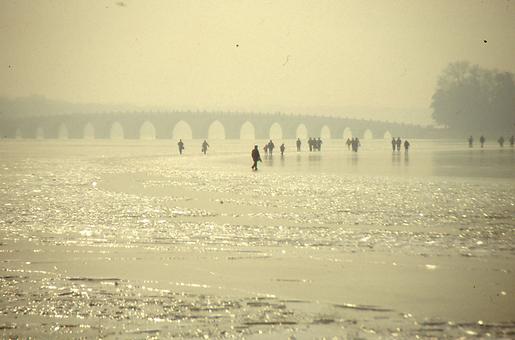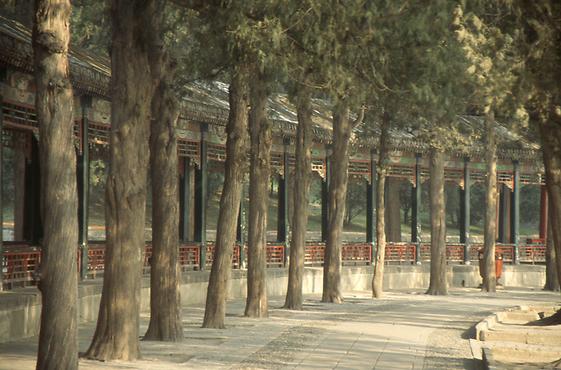The new summer palace in Beijing#
A winter's dream #
By Günther JontesAll photos were taken by the author in the years 1994 and 1996. They are part fo the archive "Picture-flood Jontes"

In moderate climate zones nature allows human habits of dresses, food, economic activity, and living different from places in a climate of eternal spring. When it was very cold in winter, European nobility lived in city palaces and celebrated joyous festivities. In summer, they moved into castles in the countryside, amused themselves with picnics and hunting, and enjoyed the park and the gardens.
Nowadays many city dwellers fulfil their dream and spend the weekends in their holiday home, no matter how small it is. At their grill stove and mini swimming pool, they have the illusion of a life of summer relaxation. We don’t have to look around too far to understand that the Austrian Empress Maria Theresia built the magnificent summer residence Schönbrunn. Her children and descendants preferred to spend the summer in Laxenburg at the gates of Vienna rather than in the very cold Hofburg, the Imperial Court of Vienna. The ideal of “noble country life” made lots of sense.
Potentates in other countries, continents, and in countries with unlimited resources concerning land, human availability and labour have the same habits. This also applies to the imperial China which ended after several thousands of years as a republic in 1911.
One of the most visited tourist attractions in the Chinese capital, Beijing, is the New Summer Palace, a monument of the UNESCO World Cultural Heritage since 1998. For a long time, China and Japan had understood to impose their will on nature, landscape, and flora. In the most sucessful cases they designed it in such a way that the visitor gained the impression that nature itself had created it without the influence of the human will. This was in accordance with the old Taoist principle of Wuwei of inactivity in the sense of letting nature and human fate take their course, and of non-interference into these eternal divine forces.
The New Summer Palace (Chinese: Yihéyuán) was a “recreation and peace garden” for the imperial family as the name is translated. It is located in the north-west of Beijing not far from the Old Summer Palace which was destroyed by the armies of the imperialist powers of Great Britain and France during the Second Opium War in 1860 and lies still in ruins today.
The New Palace was built between 1751 and 1764 by Emperor Qianlong, under which China as a territorial state had attained its largest extent with the corresponding fullness of power. This complex was an impressive landscaped garden which was also destroyed in the war mentioned like the Old Summer Palace. But the last true ruler of China, Empress Cixi, rebuilt it from 1885 to 1895. To this end, funds destined for modernization of the Chinese war fleet to protect China against the imperial powers were disapropriated.
The summer palace, as it exists today, dates from the very last time of the Chinese imperial empire. During the Boxer's uprising in 1900, however, there were devastations by the British expeditionary troops who fought this rebellion, but could soon be eliminated.
Today it seems strange that there is an unsinkable ship of white marble in the waters of Kunming Lake. It is more like a Mississippi steamer than a war junk or even a modern war ship of the 19th century. It is to be understood as subtle irony which indicates that the summer pleasures of the court were considered more essential than the reinforcement of the maritime strength of the army for the protection of the empire.

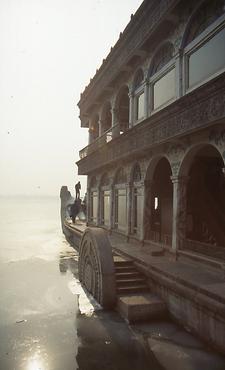

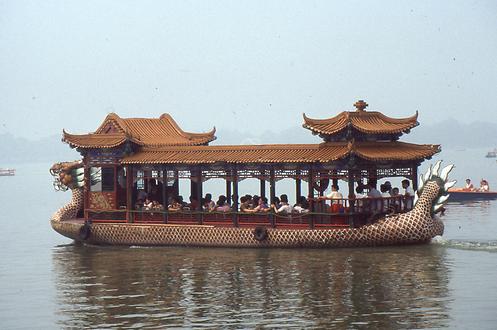
Under the scorching summer sun, lightly dressed non-swimmers enjoy the stability, while huge numbers of visitors cool off in the airflow of dragon boats on the lake which is actually a large pond dug out with human hands.
The capital Beijing is located in the north of China in a zone of continental climate with strong contrasts of seasons. There are scorching and hot summers and biting cold winters in which standing and smaller flowing water areas are covered with ice. If you visit Beijing in winter, you should not miss the Summer Palace. There is silence – the Chinese are very loud people – and you can approach the artistic attractions almost undisturbed. In winter there is mostly a blue sky on the outskirts of the metropolis, and the reflecting ice throws its blaze on the numerous surrounding buildings.
Unlike in summer, there are only a few people. You have the opportunity to admire in peace and concentration the unbelievable architectural beauty and the world of images of the 728 metres long colonnade on the lakefront.
The colonnade is slightly curved due to built-in octagonal pavilions. It is formed by 273 pairs of columns. When walking through it, the eyes are drawn upwards involuntarily, because 8000 paintings with scenes of mythology and history attract attention.
Chinese are especially attracted by depictions with the adventures and deeds of the monkey king Sun Wukong, the hero of the probably most famous classical novel of China „The Journey to the West“. It is comparable with the legends and fairy tales of the brothers Grimm in the German linguistic and cultural circle.
The plot is set in a time far away when the monk Xuanzang moved from China to India in the 3rd century BC to bring the original writings of Buddhism, this new religion, to his homeland China. The travel took 16 years, and he would have never succeeded, if the monkey king and some bizarre figures would not have stood by his side. Unlike in the West, the monkey is considered in China as loveable and sympathetic to humans. He is a great fighter and completely devoted to the monk who is entrusted to him.




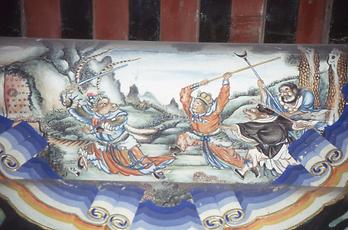
Scenes from Chinese history in unimaginable numbers, as well as other myths and literary works continue giving a good impression of China's life in the West shortly before the end of the imperial period.

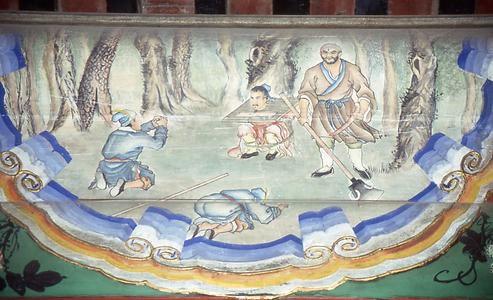

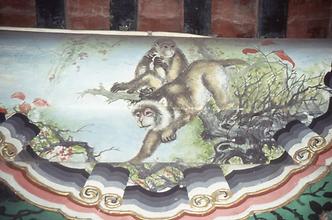

The imperial court was offered diversions in many forms. A more than 20 meters high theatre building is located in the “Garden of Virtue and Harmony” in which Peking operas with a sensational mixture of acrobatics, battle scenes, comic intermezzi, all in harmony with singing and music were performed.
The visitor is delighted by sculptures which depict fabulous animals from the rich and divers Chinese mythology each of which represents a masterpiece of bronze casting with an enormous amount of details.
A pair of male and female lions accompanies the entrance to the buildings reserved for the Emperor. They are understood as guardians. The male is always on the right and plays with a ball under his paw. This ball was originally a pearl and is the symbol for the energy taken from heaven. Lions were not originally native in China, and became known only by the spread of Buddhism from India, a lion country, in the third century BC.



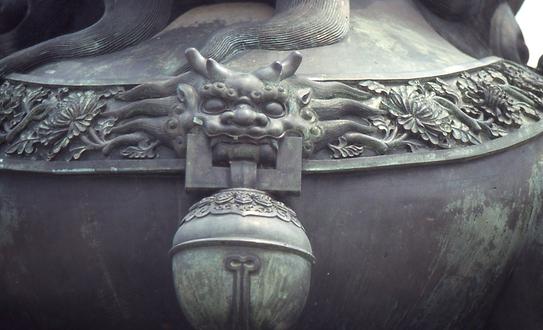
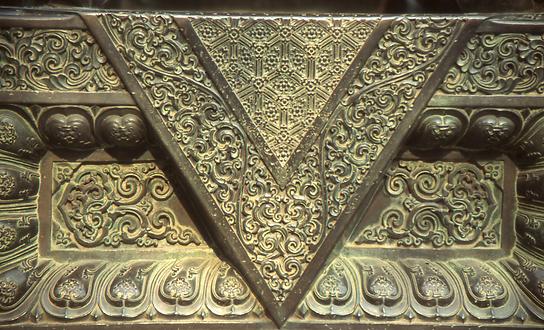
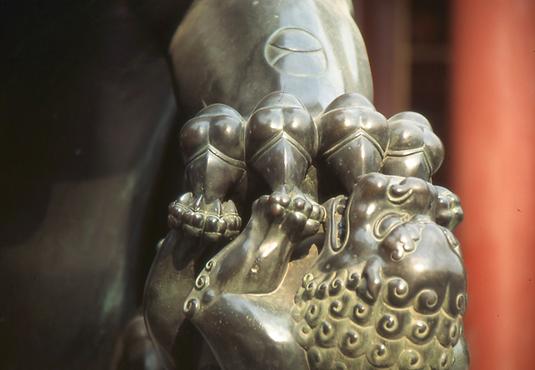
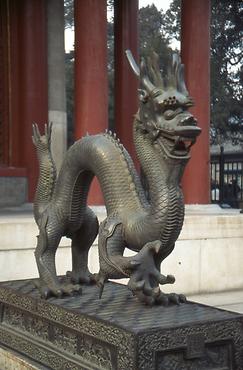

The dragon (Chinese: Long) is sympathetic to humans. It dominates water floods and distributes just the right amount of rain to humans for the timely cultivating of the fields. According to popular belief, there are dragons everywhere in mountains, rivers, caves, even in wells. Its body is composed of the characteristics of different animals and accompanies the image of the world and the religion of the Middle Kingdom from the beginning. Its body resembles that of a serpent, the head (on which a deer antler sits) resembles that of a buffalo. It has scales like a carp. Across the back, there is a crest of scales, and his legs resemble that of an eagle. Only Imperial dragons can show five claws. Its counterpart is the Fenghuang, the bird and the symbol of the Empress. The translation is phoenix, although it has nothing to do with the western-antique phoenix regarding mythology. The two symbols appear in China for the first time during the Warring States period (480-221 BC).
The Qilin is of no less importance as a mythical protector of humanity. It is a fabulous animal that protects fertility and birth, and is useful to humans in many ways. The head of this animal resembles that of a dragon, and it shows the antlers of a deer and the barbels of a carp. The body and legs, along with hooves, resemble that of an ox, while the tail is a lion’s tail.

